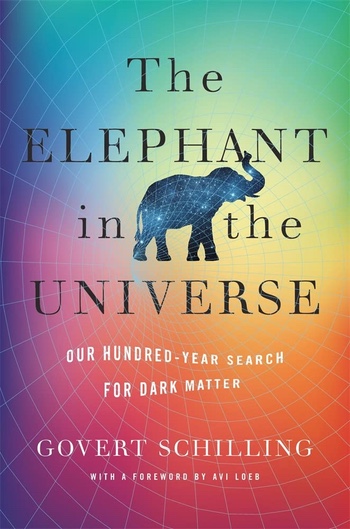Review: The Elephant in the Universeby Jeff Foust
|
| Kapteyn argued in a 1922 paper that the number of stars could not produce the gravity to explain their motions, implying the presence of what he called a “dark matter” that could not been seen. |
Yet many mysteries remain about the universe, and at the top of the list is dark matter. We see strong evidence for the presence of dark matter in quantities that far exceed the normal matter in the universe, such as through the rotational curves of galaxies. But we have no idea what that dark matter is: astrophysicists have no shortage of candidates, but no definitive proof for what makes up about a quarter of the universe.
The pursuit of something than can be felt but not seen is the subject of The Elephant in the Universe by veteran science writer Govert Schilling. While dark matter is often considered a relatively contemporary mystery, something contemplated only within the last half-century, he notes the concept goes back exactly a century to a 1922 paper by Jacobus Kapteyn, the first to accurately describe the size and shape of our Milky Way galaxy. He argued that the number of stars could not produce the gravity to explain their motions, implying the presence of what he called a “dark matter” that could not been seen.
It wasn’t until the 1970s, though, that astronomers began to more widely accept the existence of dark matter. Much of the credit for that traditionally goes to Vera Rubin, the astronomer who measured the rotational curves of dozens of galaxies, indicating they must be embedded in halos of invisible matter. However, many other astronomers were also making similar observations, and Schilling gently suggests that Rubin got too much credit: radio astronomers, for example, measured similar rotational curves before Rubin, and at greater distances from the cores of those galaxies than possible with optical data.
By the 1980s, the discussion shifted from whether dark matter existed to what constituted dark matter. Here, the mystery remains unresolved to this day. Much of the research has focused on weakly interacting massive particles, or WIMPs, but there’s been no definitive detection of such particles—if they exist—from various projects around the world. Scientists involved with one experiment, simply called DAMA (for dark matter), claim to have detected a signature in their data consistent with a “wind” of WIMPs, but many other scientists are skeptical, citing a lack of transparency in that project and an inability, so far, to replicate it.
There are more ambitious dark matter experiments in progress, in Europe, the United States, and China, leaving some optimistic that one or more might soon be able to detect WIMPs and confirm they are the long-sought dark matter. But scientists have been optimistic in the past, only to see their hopes of detecting WIMPs or other dark matter candidates fall through.
| It’s possible some of the experiments Schilling describes in the book will make that breakthrough discovery in the next few years. Or, perhaps, we’re on the cusp of a much more fundamental change in paradigms about the universe that wipes away dark matter entirely. |
Schilling devotes some discussion to the possibility that dark matter does not, in fact, exist. Modified Newtonian dynamics (MOND) can explain the rotational curve of galaxies without dark matter by tweaking Newton’s familiar laws of gravitation. The problem with MOND, though, is that it doesn’t explain anything else well. Moreover, astronomers have found cases of galaxies spinning in ways that can’t be explained by MOND, but can if they've been stripped somehow of their dark matter halo. Later in the book, Schilling talks with another astronomer who hypothesizes that dark matter might instead be some kind of interaction between ordinary matter and dark energy (a cosmological mystery for another book, perhaps.)
The Elephant in the Universe provides no clear answers on dark matter because there are none now: astronomers think dark matter exists, based on observational evidence, but have yet to observe what makes up dark matter itself. It’s possible some of the experiments Schilling describes in the book will make that breakthrough discovery in the next few years. Or, perhaps, we’re on the cusp of a much more fundamental change in paradigms about the universe that wipes away dark matter entirely. The book, though, expertly explains what we’ve learned about dark matter, and what we have yet to learn.
Note: we are using a new commenting system, which may require you to create a new account.
